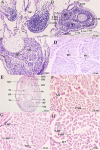Dynamic transcriptome and histomorphology analysis of developmental traits of hindlimb thigh muscle from Odorrana tormota and its adaptability to different life history stages
- PMID: 34016051
- PMCID: PMC8138932
- DOI: 10.1186/s12864-021-07677-0
Dynamic transcriptome and histomorphology analysis of developmental traits of hindlimb thigh muscle from Odorrana tormota and its adaptability to different life history stages
Abstract
Background: Systematic studies on the development and adaptation of hindlimb muscles in anura amphibians are rare. Here, we integrated analysis of transcriptome and histomorphological data for the hindlimb thigh muscle of Odorrana tormota (concave-eared torrent frog) at different developmental stages, to uncover the developmental traits of hindlimb thigh muscle from O. tormota and its adaptability to different life history stages.
Results: The development of hindlimb thigh muscle from O. tormota has the following characteristics. Before metamorphosis, myogenous cells proliferate and differentiate into myotubes, and form 11 muscle groups at G41; Primary myofibers and secondary myofibers appeared during metamorphosis; 11 muscle groups differentiated continuously to form myofibers, accompanied by myofibers hypertrophy after metamorphosis; During the growth process of O. tormota from G42 to G46, there were differences between the sexes in the muscle groups that differentiate into muscle fibers, indicating that there was sexual dimorphism in the hindlimb thigh muscles of O. tormota at the metamorphosis stages. Some genes and pathways related to growth, development, and movement ability of O. tormota at different developmental stages were obtained. In addition, some pathways associated with adaptation to metamorphosis and hibernation also were enriched. Furthermore, integrated analysis of the number of myofibers and transcriptome data suggested that myofibers of specific muscle groups in the hindlimbs may be degraded through lysosome and ubiquitin pathways to transform into energy metabolism and other energy-related substances to meet the physiological needs of hibernation.
Conclusions: These results provide further understanding the hindlimb thigh muscle development pattern of frogs and their adaption to life history stages.
Keywords: Adaptability; Anura amphibians; Development; Hindlimb thigh muscle; Histomorphology; Odorrana tormota; Transcriptome.
Conflict of interest statement
The authors declare that they have no competing interests.
Figures






Similar articles
-
The succession of gut microbiota in the concave-eared torrent frog (Odorrana tormota) throughout developmental history.Ecol Evol. 2023 May 20;13(5):e10094. doi: 10.1002/ece3.10094. eCollection 2023 May. Ecol Evol. 2023. PMID: 37214611 Free PMC article.
-
Integrated analysis of mRNA and miRNA expression profiles reveals muscle growth differences between adult female and male Chinese concave-eared frogs (Odorrana tormota).Gene. 2018 Dec 15;678:241-251. doi: 10.1016/j.gene.2018.08.007. Epub 2018 Aug 10. Gene. 2018. PMID: 30103010
-
Comparative transcriptome analysis provides insights into the molecular mechanisms of high-frequency hearing differences between the sexes of Odorrana tormota.BMC Genomics. 2022 Apr 12;23(1):296. doi: 10.1186/s12864-022-08536-2. BMC Genomics. 2022. PMID: 35410120 Free PMC article.
-
Molecular characterization, expression analysis of myostatin gene and its negative regulation by miR-29b-3p in Chinese concave-eared frogs (Odorrana tormota).Comp Biochem Physiol B Biochem Mol Biol. 2020 Feb;240:110369. doi: 10.1016/j.cbpb.2019.110369. Epub 2019 Oct 30. Comp Biochem Physiol B Biochem Mol Biol. 2020. PMID: 31676334
-
Retrofitting larval neuromuscular circuits in the metamorphosing frog.J Neurobiol. 1990 Oct;21(7):1092-107. doi: 10.1002/neu.480210713. J Neurobiol. 1990. PMID: 2258723 Review.
Cited by
-
Ozone controls the metabolism of tryptophan protecting against sepsis-induced intestinal damage by activating aryl hydrocarbon receptor.World J Gastroenterol. 2025 May 7;31(17):105411. doi: 10.3748/wjg.v31.i17.105411. World J Gastroenterol. 2025. PMID: 40521273 Free PMC article.
-
Identification of shared gene expression programs activated in multiple modes of torpor across vertebrate clades.Sci Rep. 2024 Oct 17;14(1):24360. doi: 10.1038/s41598-024-74324-5. Sci Rep. 2024. PMID: 39420030 Free PMC article.
-
The succession of gut microbiota in the concave-eared torrent frog (Odorrana tormota) throughout developmental history.Ecol Evol. 2023 May 20;13(5):e10094. doi: 10.1002/ece3.10094. eCollection 2023 May. Ecol Evol. 2023. PMID: 37214611 Free PMC article.
References
MeSH terms
Grants and funding
LinkOut - more resources
Full Text Sources
Other Literature Sources

